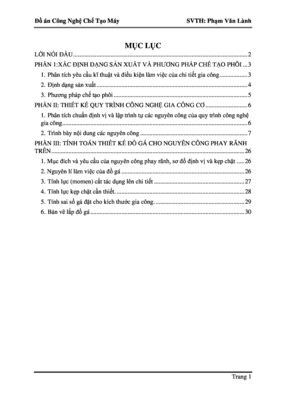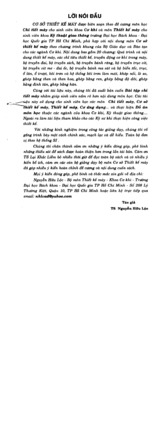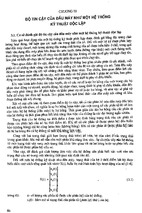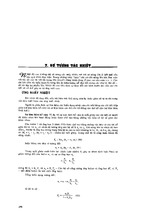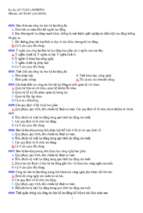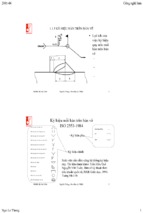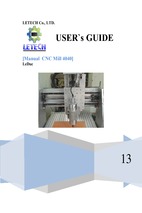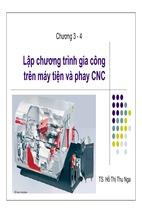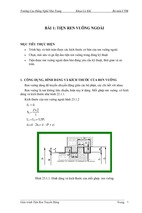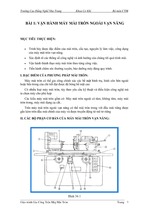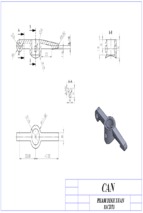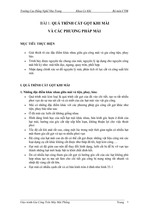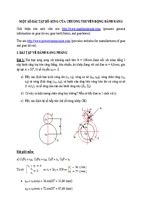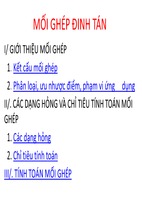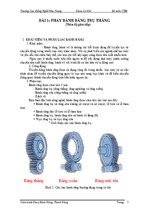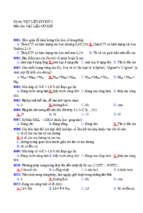Mô tả:
Generative Dynamic Response Analysis
CATIA V5 Training
Exercises
Copyright DASSAULT SYSTEMES
Generative Dynamic
Response Analysis
Copyright DASSAULT SYSTEMES
Version 5 Release 19
September 2008
EDU_CAT_EN_GDY_FX_V5R19
Student Notes:
Generative Dynamic Response Analysis
Student Notes:
Table of Contents
Master Exercise: Transient Dynamic Analysis
Copyright DASSAULT SYSTEMES
Hood Analysis Presentation
Transient Dynamic Analysis: Computing a Static Analysis on ...
Transient Dynamic Analysis: Computing the Frequency Analy...
Transient Dynamic Analysis: Defining the Transient Dynamic...
Copyright DASSAULT SYSTEMES
3
4
7
10
12
Generative Dynamic Response Analysis
Master Exercise: Transient Dynamic
Analysis
You will practice concepts learned throughout the course by building the
master exercise and following the recommended process
Copyright DASSAULT SYSTEMES
Hood Analysis Presentation
Transient Dynamic Analysis: Computing a Static Analysis on
the Hood
Transient Dynamic Analysis: Computing the Frequency
Analysis on a Hood
Transient Dynamic Analysis: Defining the Transient Dynamic
Case on a Hood
Copyright DASSAULT SYSTEMES
Student Notes:
Generative Dynamic Response Analysis
Exercise
P2
Exercises marked with this
callout will work in P2
configuration only
Transient Dynamic Analysis: Presentation
60 min
Copyright DASSAULT SYSTEMES
You will compute a Transient Dynamic Analysis to simulate a chock on a hood.
You will be able to visualize stress and displacements versus time.
Copyright DASSAULT SYSTEMES
Student Notes:
Generative Dynamic Response Analysis
Design Intent: Dynamic Analysis on a Hood
You will compute a Transient Dynamic Analysis by defining a load excitation on a hood.
You will have to compute successively a static analysis, a frequency analysis and to finish, the
dynamic response analysis. Restraints are fixed. The modulation will be applied on loads
This exercise is composed of 3 main steps:
Define and compute the static case
Define and compute the frequency case
Define and Compute the Transient Dynamic Response Analysis
Copyright DASSAULT SYSTEMES
The mesh and the modulation file are provided
Copyright DASSAULT SYSTEMES
Student Notes:
Generative Dynamic Response Analysis
Student Notes:
Design Process: Dynamic Analysis on a Hood
1
Define and Compute the
Static Response
Analysis
20’
Copyright DASSAULT SYSTEMES
Define and Compute the
Frequency Response
analysis
10’
Define the Transient Dynamic
analysis and Visualization
Results
30’
Copyright DASSAULT SYSTEMES
3
2
Generative Dynamic Response Analysis
Transient Dynamic Analysis
Step 1 - Computing a Static Analysis on the hood
20 min.
Copyright DASSAULT SYSTEMES
In this step you will :
Complete a Static Case Analysis
Apply Loads
Define Restraints
Compute the Static Case
Copyright DASSAULT SYSTEMES
Student Notes:
Generative Dynamic Response Analysis
Student Notes:
Do It Yourself (1/2)
Part used: Transient_dyn_analysis_step1.CATAnalysis
Load the pre-meshed hood
In the pre-define Static Case:
Apply Restraints using Advanced Restraints tool
Restraint the 2 hinge holes
Mesh part: All
Fix every translations (1,2,3)
Fix rotation 1 and 3
Copyright DASSAULT SYSTEMES
Restraint the front of the hood
Mesh part: All
Under the front hood, select the 2 inner edges of the holes ( see below)
Use a “User” Axis system: Axis System.1
Local Orientation: Cartesian
Fix the translation 2 only
Copyright DASSAULT SYSTEMES
Bottom View
Top View
Generative Dynamic Response Analysis
Do It Yourself (2/2)
Defining Loads: apply a Distributed Force
Support: The 2 borders faces
(highlighted-see below)
Mesh part: All
Axis system type: Global
Force Vector:
X = 5N
Y = 0N
Z = 8.66N
Copyright DASSAULT SYSTEMES
Compute the static Case
Copyright DASSAULT SYSTEMES
Student Notes:
Generative Dynamic Response Analysis
Transient Dynamic Analysis
Step 2 - Computing the Frequency Analysis on a hood
10 min.
Copyright DASSAULT SYSTEMES
In this step you will :
Define a Frequency Case
Reuse the static restraints
Copyright DASSAULT SYSTEMES
Student Notes:
Generative Dynamic Response Analysis
Do It Yourself
Part used: Transient_dyn_analysis_step2.CATAnalysis
Define a new Frequency Case
Refer the previously defined static case
Copyright DASSAULT SYSTEMES
Compute the 20 first modes
Copyright DASSAULT SYSTEMES
Student Notes:
Generative Dynamic Response Analysis
Transient Dynamic Analysis
Step 3 - Computing the Transient Dynamic Case
30 min.
Copyright DASSAULT SYSTEMES
In this step you will :
Define a Transient dynamic case
using the static and frequency
cases previously defined.
Visualize the results
Copyright DASSAULT SYSTEMES
Student Notes:
Generative Dynamic Response Analysis
Do It Yourself (1/2)
Part used: Transient_dyn_analysis_step3.CATAnalysis
Define a transient dynamic case
Refer the frequency case previously defined
Define the modulation
Import the Time Modulation Excel file that will simulate the choc
Visualize the modulation
Define the Damping
Define a modal Damping
The critical damping ratio must be equal to 1% for every nodes
Copyright DASSAULT SYSTEMES
Define the Load Excitation Set
Use the Distributed Force.1 defined in the Static Case
Select the modulation file you have just defined
Selected Factor: 50
Time Sampling
Define it from 0s to 0.5s, 250 steps
Compute the Transient dynamic Case
Copyright DASSAULT SYSTEMES
Student Notes:
Generative Dynamic Response Analysis
Do It Yourself (2/2)
Part used: Transient_dyn_analysis_step3.CATAnalysis
Visualizing Results
Displacements:
Visualize the displacements for t(s) = 0.1s
Animate the displacements for all occurrences
Search Extrema
For the occurrence 100, localize the area where displacements are maximum
Copyright DASSAULT SYSTEMES
2D Display
Visualize the graphical representation of the displacements
(Tx,Ty,Tz) of the node at which maxima located
Copyright DASSAULT SYSTEMES
Student Notes:
- Xem thêm -


